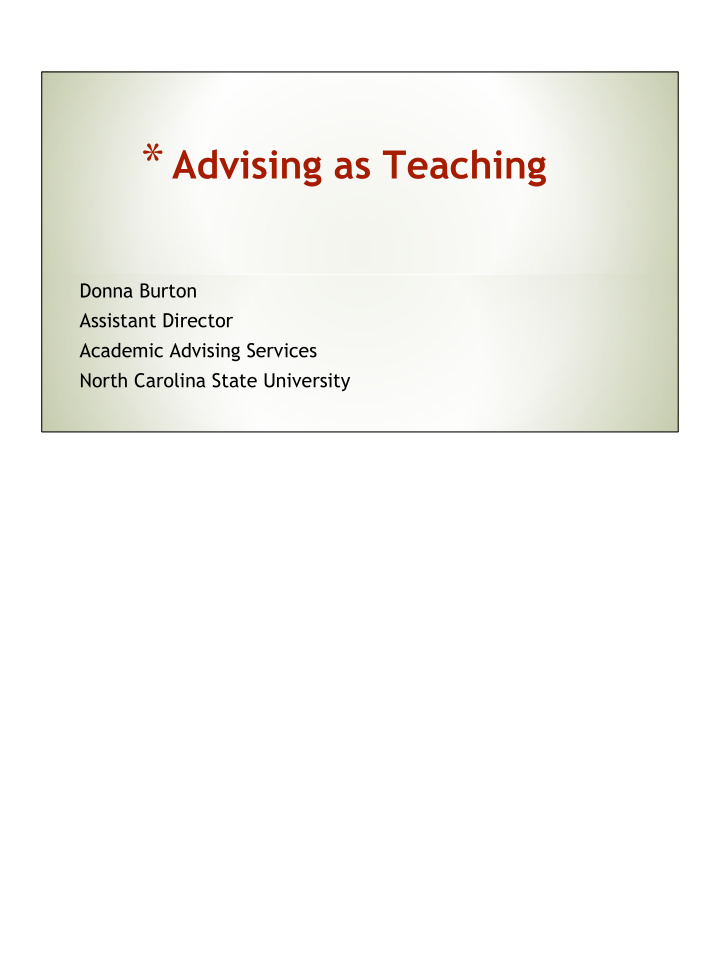



* Advising as Teaching Donna Burton Assistant Director Academic Advising Services North Carolina State University
* Be able to articulate similarities between advising and teaching undergraduate students * Know four steps for conducting a pedagogical advising session * Be able to design a session using the steps After today, you will………..
Academic advising is integral to fulfilling the teaching and learning mission of higher education. Through academic advising, students learn to become members of their higher education community, to think critically about their roles and responsibilities as students, and to prepare to be educated citizens of a democratic society and a global community. Academic advising engages students beyond their own world views, while acknowledging their individual characteristics, values, and motivations as they enter, move through, and exit the institution. Regardless of the diversity of our institutions, our students, our advisors, and our organizational structures, academic advising has three components: curriculum (what advising deals with), pedagogy (how advising does what it does), and student learning outcomes (the result of academic advising). NACADA - National Academic Advising Association - Preamble
The curriculum Knowledge students need to achieve their educational, vocational, and personal goals
The pedagogy Methods that will empower the student to continue learning
The learning outcomes What the student should be able to know, do, or appreciate as a result of advising
But what does this look like in day to day advising?
What are some parts What are some of the PEDAGOGICA L of your advising methods that you might use in CURRICULUM ? teaching advisees? What are the LEARNING OUTCOMES you have for your students?
One way to incorporate these concepts into day-to-day advising The pedagogical advising appointment
✓ Fill in the gaps – what ✓ Clarify the purpose of else does the student the appointment – needs to know? Model why is the student how to find information here today? – show you are a ✓ Gauge the student’s learner, too knowledge through ✓ With the student, questioning – have determine action items student demonstrate – homework – for the use of online tools if student to complete necessary
* Clarify “Hi, Pat - thanks for coming in today. You emailed me yesterday and said you want to drop your math course. Is that right? * Gauge the state of the student’s knowledge by asking the student to demonstrate what he or she knows “Can you log in to your online account and show me how your grades have been so far?” Go through the steps with an example. 11
* Fill in the gaps Let’s say the student wants to drop the course because of one poor test grade. The student is unaware of tutoring resources on campus. The advisor can share how these are accessed by having the student go to that website and then look at various academic support options. * Determine action items - homework “We’ve talked about your contacting the tutorial center to learn more about how they can help you improve your performance in math. Once you’ve done that, email me and let me know that has happened and what you plan to do next.” Go through the steps with an example. 12
With a partner… .. A student comes in wanting to register for Spring, 2016, courses. What is one question you can ask at each of the first two steps: ❏ Clarify ❏ Gauge the student’s knowledg e Let’s say the student doesn’t know how to select appropriate courses. What is one way you can fill in the gap ? What is one “action item” or homework you can give the student?
* Advising as Teaching http://www.nacada.ksu. edu/Resources/Clearinghouse/View- Articles/Advising-as-teaching-resource-links.aspx National Academic Advising Association Advising as teaching resource links – you do not have to be a member of NACADA to access the clearinghouse
* Questions? Contact Donna Burton at djburton@ncsu.edu
Recommend
More recommend